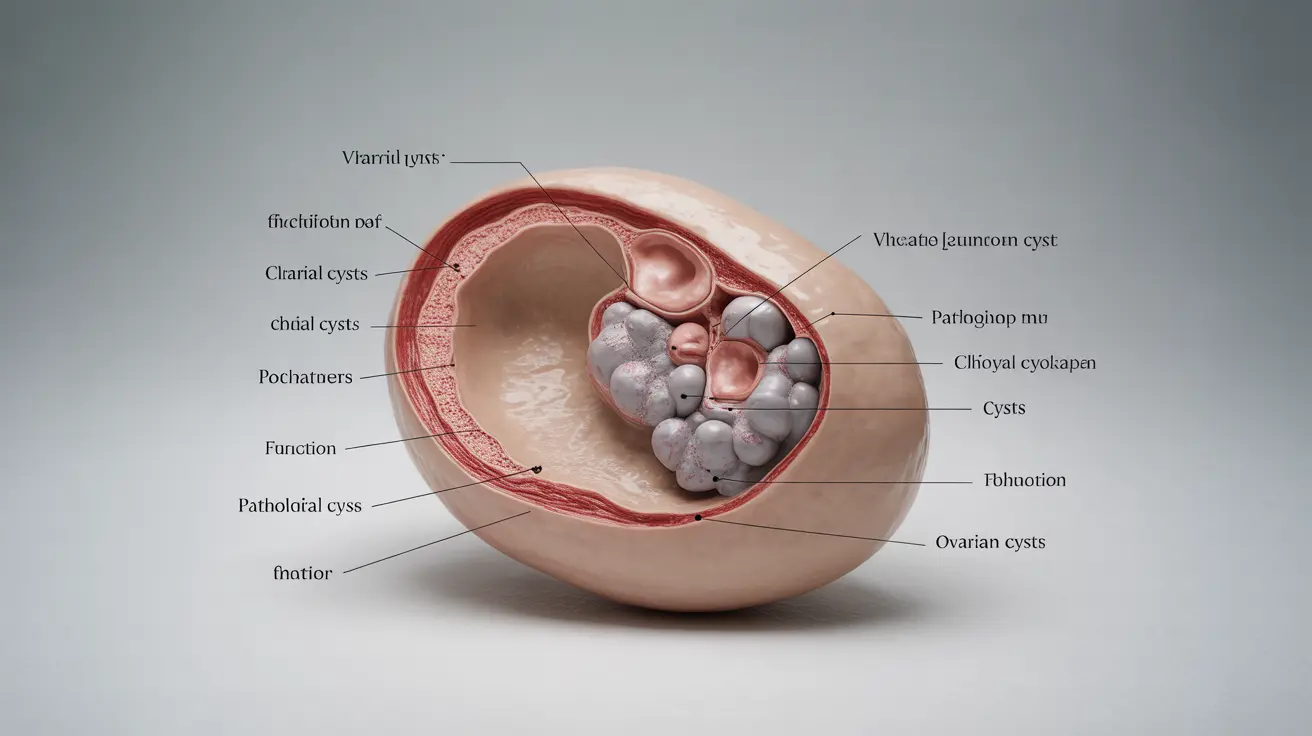Ovarian cysts are fluid-filled sacs that can develop on or inside the ovaries. While many women will develop at least one ovarian cyst during their lifetime, understanding the symptoms, potential complications, and treatment options is crucial for maintaining reproductive health. This comprehensive guide explores everything you need to know about ovarian cysts, from initial diagnosis to management strategies.
Types of Ovarian Cysts and Their Causes
Ovarian cysts can be categorized into several types, each with distinct characteristics and causes:
Functional Cysts
These are the most common type of ovarian cysts, forming during the normal menstrual cycle. They include follicular cysts and corpus luteum cysts, which typically resolve on their own within a few menstrual cycles.
Pathological Cysts
These cysts develop from abnormal cell growth and include dermoid cysts, cystadenomas, and endometriomas. Unlike functional cysts, pathological cysts may require medical intervention.
Recognizing the Signs and Symptoms
Many women with ovarian cysts experience no symptoms. However, when symptoms do occur, they may include:
- Pelvic pain or pressure
- Bloating or swelling in the abdomen
- Pain during intercourse
- Changes in bowel movements or urination
- Irregular menstrual cycles
- Lower back pain
Diagnostic Procedures and Testing
Healthcare providers use various methods to diagnose ovarian cysts:
Physical Examination
A pelvic exam may reveal swelling or tenderness in the ovarian area, prompting further investigation.
Imaging Studies
Transvaginal ultrasound is the primary imaging tool for diagnosing ovarian cysts. In some cases, additional imaging such as CT scans or MRI may be necessary.
Treatment Approaches
Treatment options vary depending on the cyst's size, type, and symptoms:
Watchful Waiting
For small, functional cysts, healthcare providers often recommend monitoring with regular ultrasounds, as many cysts resolve naturally.
Medical Management
Hormonal birth control pills may be prescribed to prevent new cyst formation and regulate menstrual cycles.
Surgical Intervention
Surgery might be necessary for large cysts, potentially cancerous cysts, or those causing severe symptoms. Options include laparoscopic cystectomy or oophorectomy in severe cases.
Complications and Emergency Situations
While most ovarian cysts are benign, certain complications require immediate medical attention:
- Cyst rupture causing severe pain
- Ovarian torsion (twisting)
- Internal bleeding
- Infection
Prevention and Lifestyle Management
While not all ovarian cysts are preventable, certain lifestyle factors may help reduce risk:
- Regular gynecological check-ups
- Maintaining a healthy weight
- Managing stress levels
- Following a balanced diet
- Regular exercise
Frequently Asked Questions
What are the common symptoms that might indicate I have an ovarian cyst?
Common symptoms include pelvic pain, bloating, changes in menstrual patterns, and pressure in the lower abdomen. However, many women with ovarian cysts experience no symptoms at all.
How are ovarian cysts diagnosed and when is imaging like ultrasound necessary?
Diagnosis typically begins with a pelvic exam and medical history. Ultrasound imaging is necessary when cysts are suspected to evaluate their size, location, and characteristics. Additional imaging may be required for complex cases.
What treatment options are available for ovarian cysts and when is surgery recommended?
Treatment options range from watchful waiting to hormonal medication and surgery. Surgery is typically recommended for large cysts (>5cm), potentially cancerous cysts, or those causing severe symptoms or complications.
Can ovarian cysts cause complications like rupture or torsion, and what are the emergency signs to watch for?
Yes, cysts can cause serious complications. Emergency signs include sudden, severe pelvic pain, fever, vomiting, and signs of shock. These symptoms require immediate medical attention.
How does polycystic ovary syndrome (PCOS) relate to ovarian cysts and what are the management strategies?
PCOS is a hormonal disorder characterized by multiple small cysts on the ovaries. Management strategies include lifestyle changes, hormonal medications, and regular monitoring. Unlike typical ovarian cysts, PCOS requires ongoing management.




